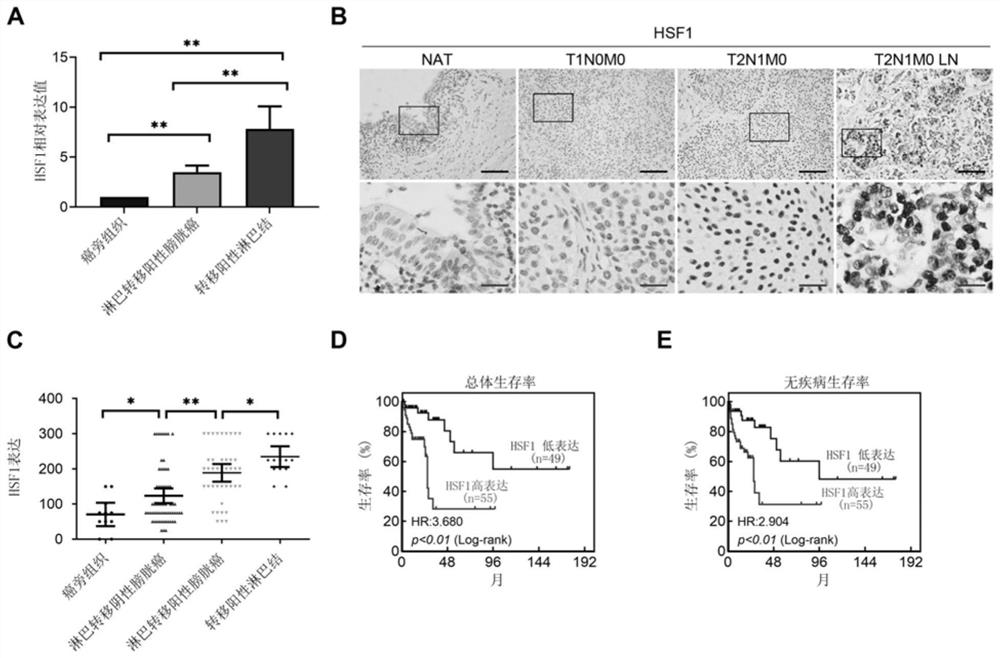Molecular marker HSF1 for diagnosing and treating bladder cancer and application thereof
A technology of molecular markers and bladder cancer, applied in medical preparations containing active ingredients, analytical materials, drug combinations, etc., can solve problems such as method limitations and poor therapeutic effects
- Summary
- Abstract
- Description
- Claims
- Application Information
AI Technical Summary
Problems solved by technology
Method used
Image
Examples
Embodiment 1
[0021] Example 1 HSF1 is highly expressed in bladder cancer, which is positively correlated with lymphatic metastasis and poor prognosis
[0022] In this example, real-time fluorescent quantitative PCR and immunohistochemical methods were used to detect the expression of HSF1 in bladder cancer tissues.
[0023] (1) RNA extraction, reverse transcription and real-time fluorescent quantitative PCR experiment
[0024] 1. Total RNA extraction: ①Tissue RNA lysis: Grind frozen fresh bladder cancer tissue into small particles in liquid nitrogen, add 1ml Trizol lysate, mix well to fully lyse the cells, and transfer to a 1.5ml EP tube. Stand at room temperature for 5 minutes. ② Lysis of cell RNA: Aspirate the medium, wash 2 times with PBS, every 10 6 Add 1ml Trizol lysate to each cell, gently pipette and mix to fully lyse the cells, transfer the lysate to a 1.5ml EP tube, and let stand at room temperature for 5min. Add 1 / 5 volume of chloroform to the lysate, vortex vigorously to mix,...
Embodiment 2
[0048] Example 2 Silencing HSF1 inhibits the in vitro proliferation and in vivo tumorigenic ability of bladder cancer cells
[0049] In this example, SiRNA-1 (Si-HSF1-1), SiRNA-2 (Si-HSF1-2), SiRNA-3 (Si-HSF1-3) and SiRNA-4 (Si-HSF1-4) were used to silence HSF1 , while using Si-Ctrl as a control. The SiRNA and Si-Ctrl were synthesized by Shanghai Gemma Company. The siRNA-1 sequence is shown in SEQ ID NO: 3; the siRNA-2 sequence is shown in SEQ ID NO: 4; the siRNA-3 sequence is shown in SEQ ID NO: 5; the siRNA-4 sequence The sequence is shown in SEQ ID NO:6; the sequence of the Si-Ctrl is shown in SEQ ID NO:7:
[0050] SEQ ID NO: 3: 5'-UAGCCUGCCUGGACAAGAA-3';
[0051] SEQ ID NO: 4: 5'-GUGCUGCCCAAGUACUUCA-3';
[0052] SEQ ID NO: 5: 5'-GAGUGAAGACAUAAAGAUC-3';
[0053] SEQ ID NO: 6: 5'-GCGGCAGCUCAACAUGUAU-3';
[0054] SEQ ID NO: 7: 5'-UUCUCCGAACGUGUCACGU-3';
[0055] (1) Cell culture and transfection
[0056] 1. Bladder cancer cell culture
[0057] Bladder cancer cell lin...
Embodiment 3
[0076] Example 3 Silencing HSF1 inhibits bladder cancer cell migration and invasion in vitro and lymphatic metastasis in vivo
[0077] In this example, SiRNA-1 (Si-HSF1-1) and SiRNA-2 (Si-HSF1-2) were used to silence HSF1 respectively, and Si-Ctrl was used as a control. The SiRNA-1, SiRNA-2 and Si-Ctrl are the same as in Example 2.
[0078] (1) Migration and invasion experiments of bladder cancer cells in vitro
[0079] 1. Cell migration experiment
[0080] (1) The Transwell chamber was purchased from Corning Company in the United States, with a pore size of 8 μm. Before use, add 200 μl of serum-free medium to the upper chamber to make the membrane hydrophilic, and absorb it before adding cells;
[0081](2) Digest the cell culture 48h after transfection, resuspend the cells with serum-free medium, count, and adjust the concentration to 2×10 5 / ml medium;
[0082] (3) Add 700 μl of medium containing 10% serum to the lower chamber, add 200 μl of cell suspension to the upper ...
PUM
 Login to View More
Login to View More Abstract
Description
Claims
Application Information
 Login to View More
Login to View More - R&D
- Intellectual Property
- Life Sciences
- Materials
- Tech Scout
- Unparalleled Data Quality
- Higher Quality Content
- 60% Fewer Hallucinations
Browse by: Latest US Patents, China's latest patents, Technical Efficacy Thesaurus, Application Domain, Technology Topic, Popular Technical Reports.
© 2025 PatSnap. All rights reserved.Legal|Privacy policy|Modern Slavery Act Transparency Statement|Sitemap|About US| Contact US: help@patsnap.com



